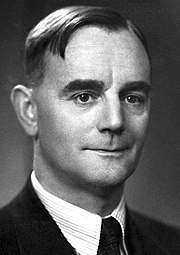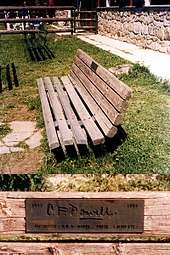C. F. Powell
Cecil Frank Powell, FRS[1] (5 December 1903 – 9 August 1969) was an English physicist, and Nobel Prize in Physics laureate for his development of the photographic method of studying nuclear processes and for the resulting discovery of the pion (pi-meson), a subatomic particle.[2]
C. F. Powell | |
|---|---|
 | |
| Born | Cecil Frank Powell 5 December 1903 |
| Died | 9 August 1969 (aged 65) |
| Nationality | English |
| Citizenship | British |
| Alma mater | University of Cambridge |
| Known for | Photographic method Discovery of the pion |
| Awards | Nobel Prize in Physics (1950) Hughes Medal (1949) Fellow of the Royal Society (1949)[1] Royal Medal (1961) Lomonosov Gold Medal (1967) |
| Scientific career | |
| Fields | Physics |
| Institutions | University of Cambridge University of Bristol |
| Doctoral advisor | C. T. R. Wilson Ernest Rutherford |
| Doctoral students | MGK Menon |
Early life
Powell was born in Tonbridge, Kent, England, the son of a local gunsmith, and educated at a local primary school before gaining a scholarship to the Judd School, Tonbridge,[3] which had one of its four houses named after Powell (the house colour is green), from 2008-2017. To this day the school awards the Powell Physics and Mathematics Prize to an upper sixth form student every year in his honour (in addition Powell is honoured by the local branch of Pizza Express, which is dedicated to him and a portrait of Powell hangs in the restaurant). Following this he attended Sidney Sussex College, Cambridge, graduating in 1925 in Natural Sciences.[3] After completing his bachelor's degree he worked at the Cavendish Laboratory, Cambridge, under C.T.R. Wilson and Lord Rutherford, conducting research into condensation phenomena, and gaining his PhD in Physics in 1929.[4]
Professional life
In 1928 he took up a post as Research Assistant to A.M. Tyndall in the H.H. Wills Physical Laboratory at the University of Bristol, later being appointed lecturer, and in 1948 appointed Melville Wills Professor of Physics.[5] In 1932 Powell married Isobel Artner (1907-1995), and the couple had two daughters.[3] In 1936 he took part in an expedition to the West Indies as part of a study of volcanic activity,[3] and where he appears on a stamp issued in Grenada.[6]
During his time at Bristol University, Powell applied himself to the development of techniques for measuring the mobility of positive ions, to establishing the nature of the ions in common gases, and to the construction and use of a Cockcroft generator to study the scattering of atomic nuclei.[3] He also began to develop methods employing specialised photographic emulsions to facilitate the recording of the tracks of elementary particles, and in 1938 began applying this technique to the study of cosmic radiation,[3] exposing photographic plates at high-altitude, at the tops of mountains and using specially designed balloons,[7] collaborating in the study with Giuseppe Occhialini, H. Muirhead and young Brazilian physicist César Lattes. This work led in 1946 to the discovery of the pion (pi-meson),[8] which proved to be the hypothetical particle proposed in 1935 by Yukawa Hideki in his theory of nuclear physics.[9]

In 1949 Powell became a Fellow of the Royal Society[1][10] and received the society's Hughes Medal the same year.[3] In 1950 he was awarded the Nobel Prize for Physics "for his development of the photographic method of studying nuclear processes and his discoveries regarding mesons made with this method" although the Brazilian Cesar Lattes be the first author and the real responsible of the discovery.[11] Debendra Mohan (DM) Bose [nephew of Sir J.C. Bose] and Chowdhuri published three consecutive papers in Nature, but could not continue further investigation on account of "non-availability of more sensitive emulsion plates during the war years. Seven years after this discovery of mesons by DM Bose and Bibha Chowdhuri, C.F. Powell made the same discovery of pions and muons and further decay of muons to electrons… using the same technique". He acknowledged in his book, "In 1941, Bose and Chaudhuri (sic) had pointed it out that it is possible, in principle, to distinguish between the tracks of protons and mesons in an emulsion… They concluded that many of the charged particles arrested in their plates were lighter than protons, their mean mass being … the physical basis of their method was correct and their work represents the first approach to the scattering method of determining momenta of charged particles by observation of their tracks in emulsion". In fact, the measured mass of the particle by Bose and Chowdhuri was very close to the accepted value measured by Powell who used improved "full-tone" plates.[12] From 1952 Powell was appointed director of several expeditions to Sardinia and the Po Valley, Italy, utilizing high-altitude balloon flights.[3]
In 1955, Powell, also a member of the World Federation of Scientific Workers,[13] added his signature to the Russell-Einstein Manifesto put forward by Bertrand Russell, Albert Einstein and scientist Joseph Rotblat, and was involved in preparations for the first Pugwash Conference on Science and World Affairs.[13] As Rotblat put it, "Cecil Powell has been the backbone of the Pugwash Movement. He gave it coherence, endurance and vitality." Powell chaired the meetings of the Pugwash Continuing Committee, often standing in for Bertrand Russell, and attended meetings until 1968.[14]
In 1961 Powell received the Royal Medal, and served on the Scientific Policy Committee of the European Organization for Nuclear Research (CERN) that year,[3] and in 1967 he was awarded the Lomonosov Gold Medal by the Academy of Sciences of the USSR (now Russian Academy of Sciences) "for outstanding achievements in the physics of elementary particles".[15]
Powell died on 9 August 1969,[3] whilst out walking in the foothills of the Alps near the Valsassina region of Italy, where he had been staying with friends. A bench with commemorative plaque was erected near the site of his death.
Cecil F. Powell Memorial Medal
- The Cecil F. Powell Memorial Medal was named in his honour by the European Physical Society.
See also
References
- Frank, F. C.; Perkins, D. H. (1971). "Cecil Frank Powell 1903-1969". Biographical Memoirs of Fellows of the Royal Society. 17: 541–563. doi:10.1098/rsbm.1971.0021.
- Camerini, U. (1969). "Cecil Powell, Cosmic-Ray Physicist, Dies in Italy". Physics Today. 22 (11): 107–109. Bibcode:1969PhT....22k.107C. doi:10.1063/1.3035243.
- Nobel Lectures, Physics 1942-1962. Amsterdam: Elsevier publishing Company. 1964. Retrieved 14 September 2009.
- Cambridge University Library
- "Nobel Prizes and Fellowships". bristol.ac.uk. Retrieved 14 September 2009.
- "Cecil Powell". Goethe-Universität Frankfurt. Johann Wolfgang Goethe-Universität Frankfurt am Main. Archived from the original on 27 March 2009. Retrieved 14 September 2009.
- "Powell, Cecil". Encyclopædia Britannica. London: Encyclopædia Britannica Limited. 1962.
- "The Nobel Prize in Physics 1901-2000". nobelprize.org. 9 February 2000. Retrieved 14 September 2009.
- Lattes, C. M. G.; Muirhead, H.; Occhialini, G. P. S.; Powell, C. F. (1947). "Processes Involving Charged Mesons". Nature. 159 (4047): 694. Bibcode:1947Natur.159..694L. doi:10.1038/159694a0.
- "List of Fellows of the Royal Society 1660–2007: K-Z". royalsociety.org. Archived from the original on 9 June 2008. Retrieved 14 September 2009.
- "The Nobel Prize in Physics 1950". nobelprize.org/. Retrieved 14 September 2009.
- "A forgotten legend". The Statesman. 23 September 2018. Retrieved 18 December 2019.
- "The First Pugwash Conference". pugwash.org. Retrieved 14 September 2009.
- "The Origins of the Russell-Einstein Manifesto by Sandra Ionno Butcher" (PDF). Pugwash History Series. Council of the Pugwash Conferences on Science and World Affairs. May 2005. Retrieved 14 September 2009.
- "Award list". ras.ru. Retrieved 14 September 2009.
External links
- C. F. Powell on Nobelprize.org including the Nobel Lecture, December 11, 1950 The Cosmic Radiation
- Portrait photograph of Powell at the American Institute of Physics

